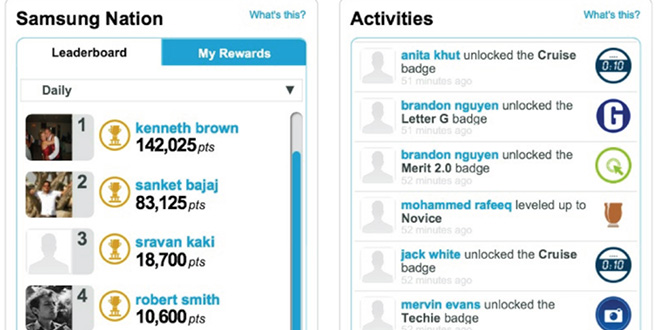PHILADELPHIA, 27 August — Coursera’s Gamification course, taught by Kevin Werbach of the University of Pennsylvania’s Wharton Business School, starts today. It’s 6 weeks with 2 “units” or “chapters” a week. Each chapter contains a number of short video lectures and other materials. Chapter 1 is What is Gamification?
PS: You can still register (free) if you want to take the class “with me.”
• Coursera.org/course/gamification
Class Notes – Part 1 – What is Gamification?
Video 1.1 – Intro
Angry Birds in its various incarnations has been downloaded over 1 billion times – can 1 billion people be wrong?
It’s hard for me to not apply a negative value judgement on this “amazing” fact. I’ve heard the founder of Kiva.org quoted as saying that their #1 competitor is Zynga! Which I guess means that “disposable online time” is very finite, and Angry Birds and Zynga and making microloans to improve life in the developing world are all realistically competing for a slice of that finite pie. Maybe the best is for me to try to avoid value judgements and simply note that people are motivated by a lot of things, and if “fun” technology can improve productivity in the school or office or even driving your Toyota Prius, then lets appeal to fun, and environmentalism, and as many other motivators as we can access.
Video 1.2 Course Overview
Learning Goals
1. What Gamification is (and isn’t)
2. Why it might be valuable
3. How to do it effectively
4. Specific Applications
not a technical, or full game design course. There is theory, but this course ultimately is designed to give us real, functional knowledge.
Video 1.3 Definition of Gamification
The use of game elements and game design techniques in non-game contexts.
Example: Nike+ – accelerometer fits in your shoe and talks to smart phone or PC. Data, goals, challenges. Makes experience of running feel somehow like a game experience.
Example: Zombies Run – lightweight game that takes experience of running and adds aspects of play. More immersive than Nike+’s challenges and rewards.
Game Elements – the toolbox, the elements, the design aspects
• Points
• Levels
• Badges, Leader Board
• Resource Collection
• Quests
• Avatars
• Social Graph (your friends)
not the whole experience, but parts of the game we can think about pulling out and reusing. Conceptual elements & aesthetics.
Cloud – Mobile – Social – Analytics
Game Design Techniques
more to games than elements – systematic design for purpose of having fun – not just pure engineering – artistic, experiential side. Think like a game designer.
Non-Game Contexts
Some objective other than success in the game: business, school, social impact
Video 1.4 Why Study Gamification
1. An emerging business practice – many companies – “striving to make everyday business tasks more engaging”
2. Games are powerful experiences
3. Lessons from psychology, design, strategy, technology – games link to basic aspects of how our minds work: Motivation, Technology – digital internet context with rich data
4. Gamification is harder than it seems! Can’t just throw in challenges & trophies.
The appeal seems pretty clear to me – but – lots of people don’t play games. Will gamefied experiences “work” for them?
Video 1.5 History of Gamification
1912 – toy in Cracker Jack box – long history of toys & rewards in products, S&H Green Stamps, etc.
1980 – Richard Bartle – MUD1 – 1st time people could experience shared virtual experience >> SL, WoW
1980-present Tom Malone, James Paul Gee – learning from games
2002-present Serious Games Initiative – Private Sector, Academia, Military – apps of games for other purposes
Games for Change – social impact – play a side in Arab-Israeli negotiations
2003 – Nick Pelling / Conundra – gamification of consumer products
2005 – Bunchball – points, leader boards – engagement purposes… now Badgeville and others…
2010 – Community reached critical mass, term “Gamification” established
Jesse Schell @ Dice2010
Jane McGonigal – book “Reality is Broken” & TED Talk – Alternate Reality Games embedded in real world
Today – Gamification starting to mature. Market research reports with big numbers.
Marshall McLuhan died before the advent of the term “Gamification,” but it seems consistent with his thinking. He talked about how much we watch ads not to make a choice, but to feel better about the choice we already made. He thought that “the product” would become a number in a file somewhere, but that the real satisfaction would be the advertisement itself.
In our culture today we define our individuality by the choice of corporate logos on our shoes, clothes, and car. Does the actual shirt matter? Or is the logo more important?
haha, WoW! Jane McGonigal is SO much more inspiring than Jesse Schell! His ideas are powerful and I think I get his satire, but he’s just so dystopian. Jane McGonigal really paints an inspiring, hopeful picture. It’s funny, I’m taking Prof. Werbach’s class not to “fight the future,” but because I’m excited at the possiblity that gamification can truly improve student engagement in the general education art classes I teach at the university. Still, Jesse Schell’s even-if-tongue-in-cheek vision is so disturbing it does make me want to rebel. When he says it’s coming we can’t stop it – well, that really is what I believe, that technological “progress” is inevetible. But the world he paints, yes he included bus riding because the government gave XPs for eco-friendly, still, he describes a future that, like the past, is driven by the needs and interests of corporate marketing. Back to “can a billion people be wrong” – I totally do appreciate that this IS the world a awful lot of people want to live in. For my weird, idiosyncratic self… I’m not so sure. Can we build a world that isn’t a slave to corporate benefit? I don’t even so much care about them making money, but that every aspect of our culture exists to serve their interests. Can you live a life without having an original thought?
As Christophe Bruno’s brilliant Google Adwords Happening, an online artwork that I reference often, showed, we sadly don’t want that Richard Stallman world where free speech is more important than free beer. WE WANT THE FUCKING FREE BEER!!! But Stallman doesn’t. Bruno doesn’t. I don’t. Can I live a fulfilled life without a billion people validating my choice? With a billion people thinking I’m nuts? Yes! I think I can…
Anyway… haha /endOfRant… back to actually trying to learn about Gamification and help my students be more engaged in appreciating the art and culture of their time.
Video 1.6 Examples and Categories
External (to your org)
– Marketing ex: Club Psych
– Sales
– Customer Engagement
Internal
– HR
– Productivity enhancement ex: Win7 Language Quality Game
– Crowdsourcing
Behavior Change – getting peeps to do something they want to, but need motivation
– Health and wellness
– Sustainability
– Personal finance
ex: Speeding – feedback speedometer boards, VW Fun Theory > Speed Camera Lottery > Stockholm decrease from 32 > 25 kmph
Gamification can Motivate.
Applications in many domains.
Encompasses many techniques.


Great article! I happened to just see an example of ‘gamification’ in Stockholm in order to make more people use the stairs. I want such stairs as well!
http://youtu.be/RpUoA5slRX4
This is terrible, now I spent the whole morning watching this sort of stuff:
http://youtu.be/VlwcLlHnTDM
Gamification seems to be part of the future already. The Jesse Schell vid left me reeling, what a joyful future that will be… erm, not. hehe. Unfortunately, I know guys who will be thrilled with a future like in the one envisioned in Sight Systems vid.
You are so right about Jane McGonigal! For one thing, and I’ve said this before, I truly believe many people are better in games than we are in real life. In fact, I know people who have learned to be better people in real life because of feedback in a virtual world.
But Jane takes this so much further. I believe Jane is onto something very big and meaningful, maybe not at the extremes but at the core. I have seen enough of her ideas in practice to buy in. In fact, I’m heading off to WoW right now (kidding, but heading to SL).
EXCELLENT post, Vanessa.
I’m right here with you, Ravanel. I’m mouth wide open in awe! Totally cool.
Thanks for “wasting” your morning Ravanel! The “gamified” / play stairs are in-flippin-credible! Wow!
Of course everybody took them instead of the boring old escalator – BUT – I wonder if that’s a 1-day effect. If you left them in place, would peeps still be taking the stairs 5 years later?
I guess when the effect starts to wane… then you have to release the Riders of Rohan Stair Expansion!!
Riders of Rohan Stair Expansion… xD
But yeah, you do have a point. I think it might still be pretty popular where they placed it (Stockholm) because it’s a big city with varying traffic… I think the fluff would’ve worn of pretty fast if they’d put it in a small town where it’s the same people that take that stair all the time. Still, I think it’s an amazing idea. 😀
Just finished 2nd Jane McGonigal vid!! This is all new to me and I think this woman is a genius. And wow, what an inspriation!!
Yes 2 all Yordie ‘n Ravanel!
Jesse / Jane really are talking about different things, still, it’s funny how he can make it feel like the end of humanity… and she can make it feel like the greatest human achievement!
I’m starting to feel that like lots of things, and like lots of media, it’s a powerful tool that is more-or-less in itself value neutral. What you do with it and how you analyze / feel about the cultural ramifications about it are their own “downstream” effects.
One interesting thing is that when students don’t like your class or your activities, they’ll often say, “oh her class was just a bunch of jumping through hoops” — yet when a gameified class is working well, “jumping through hoops” is sort of the point, AND they’re loving it!
So far my brief experience of gamification is less of the creepy I feared, and more of the powerful engagement I didn’t entirely understand / expect.
My guess is you try to build in gamification into your classes. In fact, I bet you are actually Jane McGonigal in disguise. hehe (half jk’ing)
Damn Yordie!!!
shhhhhhh…….